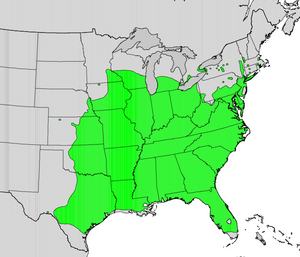Red mulberry facts for kids
The red mulberry (Morus rubra) is a type of mulberry tree. It grows naturally in eastern and central North America. You can find it from places like Ontario and Minnesota down to Florida. It also grows west into Texas.
This tree is common in the United States. However, it is an endangered species in Canada. The red mulberry can also mix its genes with the invasive white mulberry. The white mulberry came from Asia.
Quick facts for kids Red mulberry |
|
|---|---|
 |
|
| 1809 illustration | |
| Conservation status | |
| Scientific classification | |
 |
|
| Native range |
Contents
What Does the Red Mulberry Tree Look Like?
The red mulberry is a deciduous tree. This means it loses its leaves in the fall. It usually grows about 10 to 15 meters (33 to 49 feet) tall. Sometimes, it can reach 20 meters (66 feet) high. Its trunk can be up to 50 centimeters (20 inches) wide. This tree can live for up to 125 years.
Leaves and Bark
The leaves grow alternately along the branches. They are about 7 to 18 centimeters (3 to 7 inches) long. They are also 8 to 12 centimeters (3 to 5 inches) wide. This makes them about twice as big as the leaves of the white mulberry. Red mulberry leaves are broadly heart-shaped. They often have a shallow notch at the bottom.
On older trees, the leaves usually don't have lobes. But on young trees, they often have 2 or 3 lobes. The edges of the leaves are finely serrated, like a saw. The top surface of a red mulberry leaf feels rough. It's like fine sandpaper. The underside is covered with soft hairs. If you break the leaf stem, a milky sap comes out. In autumn, the leaves turn yellow.
Red mulberry trees are tough. They can handle very cold temperatures. They are also quite good at surviving droughts, pollution, and poor soil. However, the white mulberry is even hardier.
Flowers and Fruit
The flowers are small and not very noticeable. They are yellowish-green or reddish-green. They open when the leaves start to grow. Usually, male and female flowers grow on different trees. But sometimes, both can be found on the same tree.
The fruit looks a lot like a blackberry. It is 2 to 3 centimeters (about 1 inch) long. At first, the fruit is pale green. As it ripens, it turns red or dark purple. Many birds love to eat these berries in spring and early summer. In Arkansas, people have seen as many as 31 different kinds of birds visiting a single fruiting tree!
How People Use Red Mulberry
The berries of the red mulberry are edible and very sweet. Early English settlers in Virginia in 1607 wrote about how many mulberry trees and fruits there were. The native Powhatan tribes ate the fruit, sometimes even boiling it.
Today, people eat mulberries fresh. They also use them in pastries, like pies. Some people even ferment them to make wine.
Wood and Other Uses
The wood from the red mulberry tree can be dried. It is used for smoking meats. It gives the meat a mild and sweet flavor. The Choctaw people, a Native American tribe, used the inner bark of young red mulberry trees to weave clothing.
See also
 In Spanish: Mora roja para niños
In Spanish: Mora roja para niños


